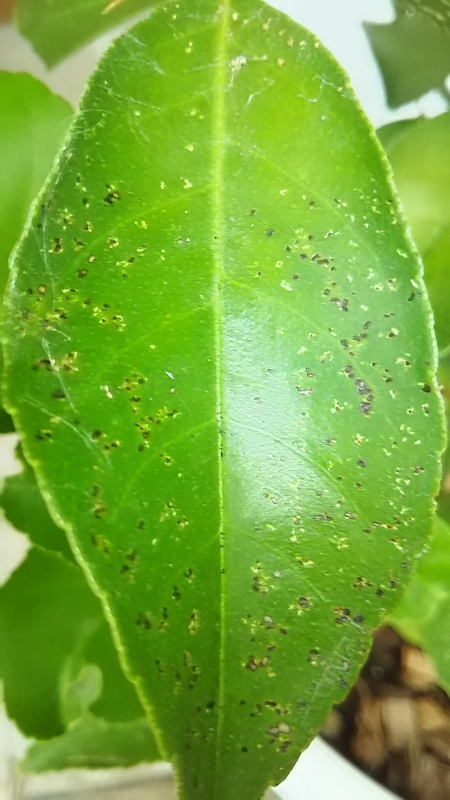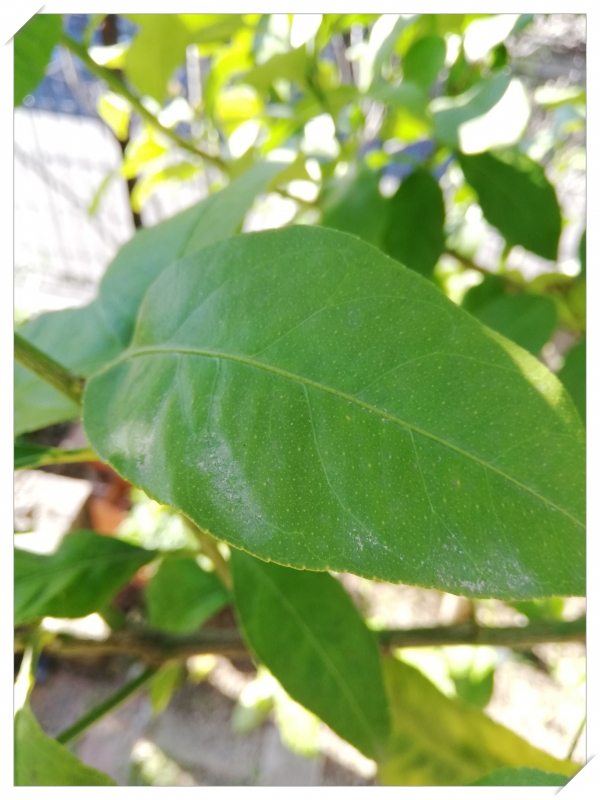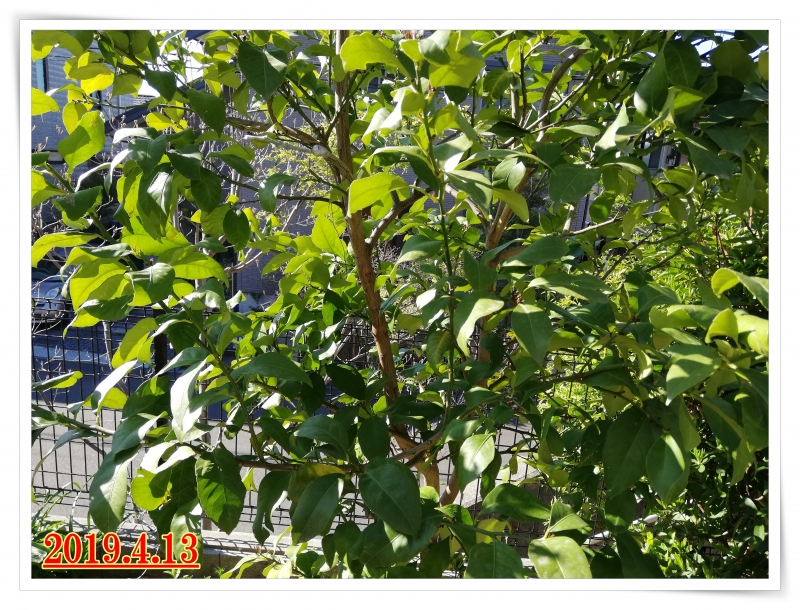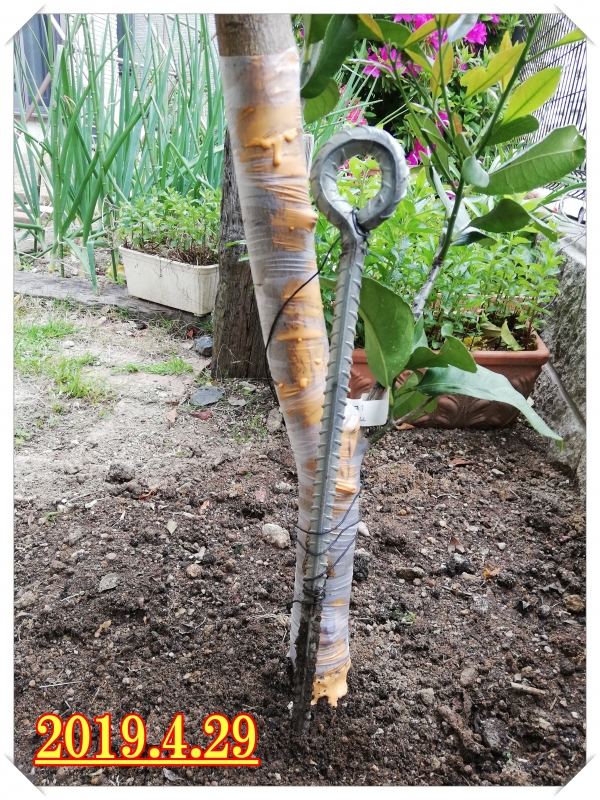Know the pests and diseases
and take action to protect the lemon tree!
I took care of lemon for the first time in two weeks.
What was so sad was that
there was a huge outbreak of "coccoidea".

When it broke out before,
I rubbed it down with a "toothbrush".
I thought I had removed everything.
White dots were left a little,
I thought that there was a possibility that something might happen.
But,
So much ...
I did not think that it would berak out again.
Also today, I rubbed it down with a "toothbrush".
And I thought while rubbing it down.
Speaking of commonplace, but it is ...
Countermeasures against diseases and pests
do not end with one action,
but continue over and over again.
Basically I have a bad memory.
「Eh ~ ~, I wonder what it was.」
I will check again each time.
I also forgot today.
"I used to write blogs for Coccoidea and Melanose,
but I wonder what the title of the article is?"
In fact, I do not remember・・・ ^^;
So I will make a blog post
about diseases and pests,
and I will add what I studied in the future.
1、「If you leave Coccoidea as it is・・・」
There is direct damage and indirect damage.
Direct damage is that
the attached Coccoidea itself loses its aesthetic appearance
and it has a negative impact on its growth
because the nutrients of its branches are absorbed.
If the number of parasites of Coccoidea is large,
the appearance of shoots and new leaves may be poor,
and it may cause withering.
Indirect damage is that
"Cercospora leaf mold" reproduces on the excrement
and the leaves are black.
Not only the aesthetics are lost,
but also the photosynthesis important for plants is disturbed
and the growth becomes worse.
In addition,
it induces a "felt (koyaku-byo)"
that seems to be attached to a velvety thing
at a parasitic place such as a branch.
The unusual damage symptoms
may cause roundish white spots of around 5 mm on branches and trunks.
This is a trace that Coccoidea was attached.
(Various theories)
2、「Melanose」

It will be seen during the rainy season from June to September.
The high temperature period around August
and the temperature decrease period after November
are slow to spread even if they occur.
Melanose bacteria in the soil bounce off in the rain,
and get caught on the lower leaves
and get infected.
It will occur frequently when the rain continues.
When the leaves decrease,
the ability of trees to grow weakens,
and it becomes difficult to bloom.
Fruit trees often suffer from this disease.
👉 Workaround
Immediately remove the diseased leaves
and clean up immediately without leaving the fallen leaves.
The treatment medicine is applied 3 to 4 times
at intervals of 3 days.
※ If all the leaves fall without curing the disease,
arrange dead thin and small branches
and trim these branches lightly.
It will be effective to clean up the diseased leaves
that have fallen to the ground
and give more potassium fertilizer for prevention.
If new shoots come out after removing the diseased leaves,
apply a preventive drug to prevent recurrence.
In the case of potted plants,
it is also effective to evacuate to a place where it does not rain.
It is also good to sterilize the ground surface at the same time.
3、「Bell moth」(Hamakimushi)

Hamakimushi is a larva of the bell moth.
Representative bell moth are Homona magnanima,
Adoxophyes orana etc.
Roll the leaves with threads that they put out,
live in it, and eat leaves and sprouts.
It not only impairs the beauty of plants
but also interferes with the photosynthesis of leaves.
Therefore, damage such as delayed growth occurs.
In addition, by eating the bud, the deformed flower blooms.
Besides,it invades from the surface of the fruit and causes drop of fruit.
Bell moth (Hamakimushi) occurs in many plants
including flowers and vegetables, garden trees,
and fruit trees from April to November excluding midwinter.
It occurs three to four times a year
and becomes active especially in the hot season of July to August,
so adults and larvae repeatedly occur and the damage spreads.
The adults fly around at night and lay about 200 eggs at a time.
The eggs hatch in about 14 days,
and they become the pupas(sanagi)in about 1 month.
It is important for early detection and elimination.
If it occurs in large quantities,
all the leaves will be squeezed with a thread,
and it will be eaten from the inside and the plant will die.
If the larva lurks in the leaves,
the drug does not work directly,
so it is difficult to take effect.
So, as soon as you find it, pick up the leaves.
Also, if you find an egg on the surface of the leaf,
pick the leaf itself up and discard it.
When a lot of Bell moth (Hamakimushi) has been generated,
the medicine(Sumithione emulsion, Oltrran solution /
wettable powder, marathon emulsion etc.)
will be applied to the surface of the leaf and inside.
4、Please careful about manure desperation !
(It is not sick...)
As much as we give a manure, it is not good.
The density of fertility in the soil rises when I fertilize it too much,
and the water of the root is robbed of it under the influence of osmotic pressure.
It can be expected,
"a lemon withers up even if I put up a lot of water".
In the future, while writing a blog,
when I write an article about pests and diseases,
I would like to add it to this page ...
・・・・・・・・・・・・・・・・・・・・
October 22, 2017
A lot of Melanose broke out.
The article at that time is 「here」!
March 20, 2018
I found the first Coccoidea that year and dealt with it.
The article at that time is「here」!
・・・・・・・・・・・・・・・・・・・・
April 14, 2019, Sunday
It has been four years since I began planting
and growing lemons in the garden.
And it enters the fifth year of this year.
(I have only a few experiences yet)
Basically, I aim at pesticide-free cultivation,
so I do not use pesticides unless there is anything special.
What I feel over the last 4 years.
Certainly, lemon trees suffer from various pests and diseases.
For example, this is the state of the lemon leaf of my house now ...




A lemon tree was damaged by Citrus leafminer (Ekakimushi)
and Bell moth (Hamakimushi).
Some of the leaves became white or yellow.
As mentioned above,
there were damage to Melanose and Coccoidea.
However, by just doing a small measure at that time,
it did not become a big damage.
I have grown lemon trees for four years,
but now I have something to think about.
If there is a big concern with pests,
are not only larva of the swallowtail butterfly?
Larva of the swallowtail butterfly eats leaves very much,
so once you find it you need immediate removal.
I observed on the day off and removed it by hand.
I took it by hand and transferred it to a flower Yuzu.
There is no major damage just by removing it by hand.
There are four leaves above.
However, if you look at the whole ...

It is like this.
It is not a state of being severely damaged.
The annual growth is like this.


However, a pione (grape) which is raised separately
is eaten by the larvae of Longhorn Beetle(teppoumushi).
So I am afraid of the longhorn beetle.
Be careful if wood chips appear around the root area.
It seems that there is a possibility that the tree itself will wither.
If the upper branch is eaten, just cut the branch.
However, there is no way to deal with the root area,
so I would like to be careful every day.
And, please be careful about "the cold".
"Cold" is not a disease,
but lemon trees can be completely killed by "Cold".
My house is in a residential area
and I grow lemons in that garden.
I have received guidance that
"If you grow lemons in a residential area garden
in the Kansai area of Japan,
you do not need to take measures against cold at all."
If it is a residential area in this Kansai area,
it is said that the lemon will not get cold enough to die.
Areas such as groves seem to be colder than
residential areas because of strong winds.
However,
I would like to continue my observation carefully.
・・・・・・・・・・・・・・・・・・・・
About "Slug"
My lemon pot was on the bench.

However, a complaint came from my wife
and grandmother.
① There is no place to dry zabuton etc!
② As I do water as it is, the bench becomes tattered!
③ First of all, this is the place to sit down!
So, I changed the place to put it because I am sorry.

Replaced on top of the brick of the rim of the flower bed.
There are other pots, but there is still space.
In less than a week ... full of slug ...
Concentrated 5 to 7 slugs gather in the lemon seedlings.
Slug eats soft leaves, buds and petals of plants.
I think that slug does not eat all the leaves etc.
like a larva of the swallowtail butterfly.
However, I did not think that so many slugs would gather.
I returned the lemon seedlings to the bench
so as not to cause mass outbreaks.
Then, it seems that slug can not go up on bench.
In the case of potted plants, it may be better to choose a place.
・・・・・・・・・・・・・・・・・・・・
Blight?
*April 28, 2019 I found that sap was spouting!
Are there many falling leaves?
It is strange that leaves fall at this time・・・
I thought so and observed the condition of the tree.
I found a lump of sap near the base of the ground.
Seeing from the front, it was just behind.

I thought, "This was done by a longhorn beetle!"
And I looked for a hole.
However, there is no appearance of wood chips and poop.
The small hole itself can not be found.
I tried to prick a few places with a screwdriver,
but I could not find a place where the inside was hollow.
Is not a longhorn beetle?
When I look closely,
I feel that the skin of the trunk is being scratched
rather than that the hole is open.
And although it feels like it has already dried and healed,
there was a similar scar on the upper surface of this branch.
It seems to be similar to the symptoms of blight.
This may be pretty bad.
In case of blight,
it seems that there is no choice
but to cut off the branches or peel off the trunk.
I immediately applied top Gin M paste,
which was effective as wound healing and disease prevention.
And, I wound the part with Medale tape.


I would like to see the situation for a while now.
If the symptoms get worse then let's peel off the skin next.
If it still doesn't be cured of illnessget・・・・ ^^;
The lemon tree may die・・・
Poor drainage, excessive pruning, and cutting thick branches
seem to make it more susceptible to disease.
In particular,
if you cut a thick branch,
apply a cohesion promoting agent such as Topjin M paste
and block the cut,
so that it is necessary to prevent the bacteria from entering the branch.
Even the places where it was difficult to see
should be observed enough.
I must reflect on it.
・・・・・・・・・・・・・・・・・・・・
Postscript
In the article 「How to grow lemon」,
I tried to summarize the cultivation article
of lemon.
I hope you can read it.
You can see an article
that summarizes diseases and pests
from 「here」!!
Table of Contents untill 5-6.
<Contents>
👉 Coccoidea
👉 Larva of the swallowtail butterfly
👉 Citrus leafminer (Ekakimushi)
👉 Bell moth
👉 Aphid
👉 Spider Mite (Mikanhadani)
The continuation is 「here」!!
Table of Contents from 5-7.。
<Contents>
👉 Longhorn beetle
👉 Thrips
👉 Melanose
👉 Xanthomonas campestris pv. citri
👉 Elsinoë fawcettii
👉 Gray mold
👉 Cercospora leaf mold
I can also exert myself、
if you push this banner!!
( my dog, namely KORO )
Thank you.


